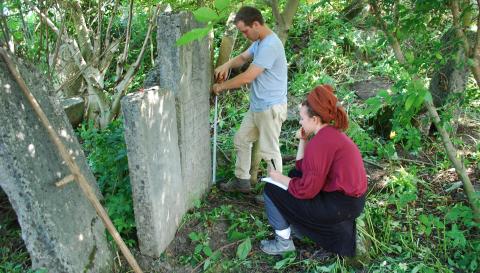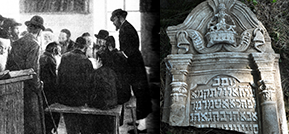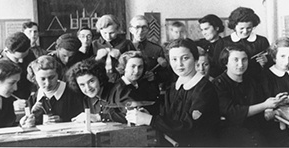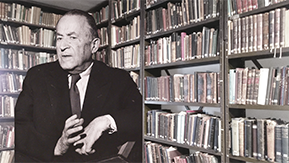
The 11th expedition of the Jewish Galicia and Bukovina Organization worked in two towns of great importance to the history of Galicia: Kalush and Busk. Both towns had old and developed Jewish communities which influenced Jewish life in the whole region. In both of them Jewish cemeteries had survived to tell the centuries long stories of the lives of their communities and their tragic endings during the Holocaust.
The volunteer group appointed 13 people, most of them students of Herzog College that took prior to their travel a special course on the history of the Jews of Galicia and Bukovina. In addition, the delegation's activity involved local officials: representatives of the community of Ivano-Frankivsk (formerly Stanislawow) and Ukrainian public activists interested in the Jewish heritage of their towns.

Already the first days of the work in the Busk cemetery yielded surprising findings. It was known previously that Busk is the home to the oldest Jewish gravestone in Ukraine - dated 1520. But the JGB delegation uncovered and documented more than 10 additional gravestones from the period between the late 15th century and the early 17th century: large stone tombs with impressive rabbinic phraseology that were unknown to researchers. It is kind of sensational finding, because tombstones (especially with such an elaborate inscriptions) from before the 1648 Khmelnytsky massacre are extremely rare in Eastern Europe. They are unique testimony to the longevity and strength of the Jewish community in this early period and pour a new light on the history of the Jews of Galicia.
Another interesting finding, one that has not been found by us in other cemeteries is a special section of tombstones of community doctors who worked in the town in the second half of the nineteenth century. Among them there was discovered the tombstone of the community’s doctor, Arie Yehuda Leib (Leon) Szeps, the father of Moriz Szeps (1835-1902) – a Vienna press tycoon and a prominent activist in the liberal movement in the Austro-Hungarian Empire.
500 tombstones were documented in Busk, all that has survived in this important cemetery. We owe a special thank you to the historian Mr.Ivan Tzichotzki who helped us and even gathered local volunteers who helped us a lot in preparing the cemetery for documenting.
The cemetery in Kalush lies in a residential neighbourhood built in the late soviet era. It seems like parts of the cemetery were damaged and destroyed during the building but around 1000 tombstones from the beginning of the 18th century until the Holocaust still stand there today. In the past year the city’s gymnasium took care of the cemetery which is next to its yard. Students and teachers worked cleaning the cemetery and cutting the vegetation. But the site is still neglected and awfully dirty.

In July this year a small group of students from Mohyla university in Kyiv started the documentation work at the cemetery and our delegation continued and finished it. Around 1000 tombstones were found on the site, all of them were cleaned, photographed and documented. Both groups enjoyed the support and help of the Gymnasium: from the principals, teachers and student who sometimes joined the delegations work.
The work of the delegation was covered by local and international media.
All findings of the delegation will be processed and will be accessible on the JGO site in the near future.







